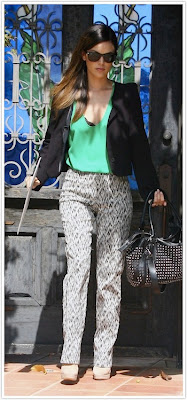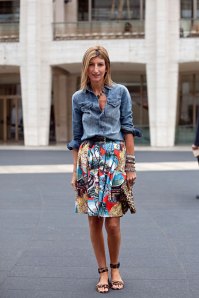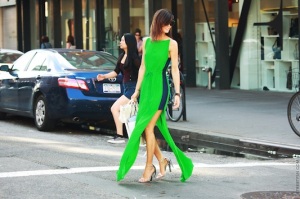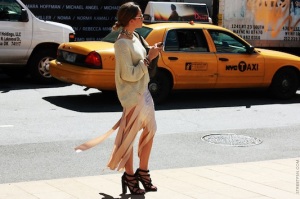Venice_Sept2011_byABattista In a post in June I mentioned spending some time in Venice with Olivia Mihaltianu, Anca Mihuleţ and a couple of members of Apparatus 22 - Maria Farcas and Erika Olea - for a project that would have been unveiled in September.
Well, that project - the exhibition “Situated Knowledge: I Follow Rivers of Thoughts” - finally opened last week at the Institutul Cultural Român (Romanian Institute of Culture and Humanistic Research) in Venice. Being a writer and journalist, my input came in the form of a small publication linked to the event and featuring interviews with the artists and theoretician involved. So let's discover what the exhibition is about.
The word “knowledge” first appeared in English in 1200, a contraction of the verb gecnawan, then cnawan, plus the suffix -leacan. The word meant “state or fact of knowing”, indicating the process that went behind the “act of knowing”. Like the Latin cognosco (literally “I begin to know”, “I begin to acknowledge”), this word has a sort of dynamic meaning behind it. Indeed “knowledge” is not something that exists a priori, but it is dynamically created right when a process of research begins.
Venice2_Sept2011_byABattista There are also two other important meanings connected with this word: in 1200, knowledge also meant “confession” since the word indicated a secret, private or reserved knowledge owned by a person. Yet there is also a third element that should be connected to the word knowledge through its Indo-European root (gn-/gen-/gne-/gno-): from the same Indo-European root we indeed form (through the word gnarus, expert) the term (g)narrare, that hints at the fact that the best way to transmit knowledge is narrating it.
The artist, theoretician and creative collective in the “Situated Knowledge: I Follow Rivers of Thoughts” exhibition seem to reunite in their work and in the research process behind it, the dynamic meaning of the word “knowledge”, together with the desire of spreading a secret knowledge and of doing it through a narration, be it visual, written or transposed into a wearable garment.
SituatedKnowledge_3_byABattista Walking into the exhibition space to listen to their stories and doing it in Venice is almost symbolical and brings to mind the secret doors hidden away in three magic places – Calle dell'Amor degli Amici, Ponte delle Maravegie and Calle dei Marrani near San Geremia in Ghetto Vecchio – that Venetians step through to reach different dimensions and discover new and fascinating stories, as Italian writer and comics author Hugo Pratt wrote in Corto Maltese.
Leaving behind the chic existentialism, isolation and alienation of Michelangelo Antonioni’s films explored in her previous project “Anyone But Me, Anywhere But Here” and the pensive and emotional moods of “Smoking Room, Where Do We Go From Here?”, a remake of a ‘20s film, visual artist Olivia Mihaltianu moved onto Spaghetti Westerns (and Osterns – that is Westerns from the Eastern Bloc) to look at the role of the artist.
SituatedKnwledge5_byABattista Traditionally men were the protagonists of most Spaghetti Western films, though Sergio Leone dared to portray a strong woman living in a prevalently male universe in C’era una volta il West (Once Upon a Time in the West, 1968). In this film Claudia Cardinale starred as Jill McBain, a widow who challenges the male authority. Like in Leone’s dramatically stylish movies, the protagonist of Mihaltianu’s film is a woman, though in this case she questions issues of art and identity, analysing them in relation to different cultural and economic contexts.
Clad in a Western inspired attire, Mihaltianu finds herself in places overcrowded with tourists, rides a stone lion in Venice’s St Marks’ Square, explores desert areas that look more similar to the glamorous Lido than to the arid landscapes of a Western film and pretends of being engaged in a lethal duel among the pavilions at the Giardini della Biennale.
Displaced, travelling on a ferry rather than on a train, moving from Venice to Sofia and Vienna, with no isolated forts or oil flowing under a ranch to defend, with no bad or ugly guy to shoot and no damsel in distress to save, Mihaltianu’s semi-nomadic wanderer can not conquer any kind of wilderness. Yet she perfectly adapts to the new situations she lives using her video camera like a gun or pretending she is assaulting the big flaming red safe inside the Vienna-based KulturKontakt Gallery, with the irony of Claudia Cardinale and Brigitte Bardot in Christian-Jaque’s kitsch Euro Western Les Pétroleuses (The Legend of Frenchie King or Petroleum Girls, 1971), smiling in the face of unfamiliar situations, ready to rebel to an established film genre and to its aesthetics and reinvent it.
SituatedKnowledge2_byABattista Anca Mihuleţ’s project is instead a perfect example of how knowledge can be created in a dynamic way. A researcher, art critic and curator, Mihuleţ arrived in Venice with the hope of being able to look into the archive of the Romanian Cultural Institute and discover more about the people who collaborated with the institution in the ‘30s. Finding no archive and no useful documents at local libraries such as the historical Correr Library, and discovering that even the documents stored in the archives of the Sibiu-based Brukenthal Museum weren’t offering any insight into the work of Nicolae Iorga, the founder of the Cultural Institute in Venice, and inspired by her interest in pharmaceuticals and hygiene, Mihuleţ changed research topic and moved onto drugs. Rather than exploring the literature of drug addiction with its powerful strong visual experiences conjured up by writers as different as De Quincey, Baudelaire and Coleridge, Mihuleţ looked at how opium, heroin and cocaine were often employed in Romania in the 1930s as active components in medicine. When drugs were banned, old pharmacies still kept on using them, but most of the documents regarding the legal use of narcotics soon went missing.
Finding herself once again without useful materials, Mihuleţ came up with a pocket guide for the young researcher (the blue paper in the fifth image in this post) that traces a path through different types of knowledge and research. Mixing history, real data and speculation, Mihuleţ tries to define a researcher’s good practice, highlighting the different types of researches and the importance of skills such as intuition, deduction and speculation, creating a new figure for the digital era, the modern and dynamic “Action Researcher.” The nemesis of the “Traditional Researcher”, more focused on pure and historical facts, “The Action Researcher” is a wandering and maverick figure with an unstoppable will for reconstructing missing information through correlations and connections and for recreating his or her own study contexts.
SituatedKnwledge4_byABattista In a way the members of the Apparatus 22 team could be considered as “Action Researchers” as well since they recreated for this exhibition a new context that moves from an iconic garment from the ‘20s and gives it a new life and an innovative meaning.
Apparatus 22’s project is inspired by painter, sculptor, fashion, set and costume designer Ernest Henry Michahelles, better known as Thayaht. Together with his brother Ruggero (Ram), Thayaht designed in 1919 a functional garment called “Tuta” (overalls).
The garment, presented in 1920 through the Italian newspaper La Nazione that also sold its pattern cutting as a supplement, was characterised by simple and basic geometric lines and harmonic forms that called to mind the rigid shapes of Italian rational architecture.
A revolutionary, innovative and futuristic design that guaranteed freedom of movement to the body and a great dynamicity, the “Tuta” was supposed to have a universal value since it could be worn by both men and women to carry out different activities. One illustration by Ram entitled “Tuttintuta” (literally “Everybody in Their Overalls”) showed indeed a worker, a painter and an intellectual wearing the garment and happily walking arm in arm. Originally created to save time, money and fabric, the Tuta was first conceived as a reaction to the increasing prices of fabrics in the aftermath of the First World War. An early advert for the tuta stated: “Per toglier l’ingordigia ai pescicani/che ci hanno il vizio ormai di speculare (…) abbiam trovato il modo di risparmiare/e i nostri sforzi non saranno vani” (“To make the sharks who have the vice of speculating less greedy/we found a way to save money/our efforts won’t be vain”).

A must in the summer of 1920 and later on adapted for women and patented by the Maison Vionnet in collaboration with Thayaht, the Tuta was also the first garment created in Italy that looked at mechanical reproducibility and introduced the idea of ready-to-wear. Inspired by their previous fashion and art projects, Apparatus 22’s “Art is Work” uses the Tuta, its mechanical reproducibility and limited manufacturing costs to comment upon the conditions of many contemporary artists – especially those ones without rich patrons supporting them – working for free. Utopia and social issues combine in this project giving a new purpose to Apparatus 22’s Tuta: this garment can indeed be manufactured by artists all over the world and emblazoned with two different statements tailored for artists who were paid or not paid for their work.
There is a sort of bitterness and provocation behind each project, from Mihaltianu’s Western girl travelling through different European locations looking for her identity, passing through Mihuleţ’s research that leads not to a discovery but to the creation of a new figure of researcher, and to Apparatus 22 questioning the role of contemporary artists and asking with a garment “Do you really think artists feed on glory?”

Bizarrely enough, some attribute the etymology of the word “glory” or its Latin “gloria” to the Indo-European root gn-/gen, the same root behind the word “knowledge”. So glory would originally be the blissful situation of those ones “who can boast about possessing knowledge”. If glory distinguishes those ones who have knowledge from those one who haven’t got it, well, the artists featured in this exhibition are truly “glorious” because they have a kind of knowledge of their own. To reach their glorious status follow their stories, listen to what they have to say and finally be ready to step into their narrations exactly like those Venetians who, running away from the madding crowds of tourists and tired of the constituted authorities, as Pratt says, step through secret doors and enter new and mysterious dimensions.








































